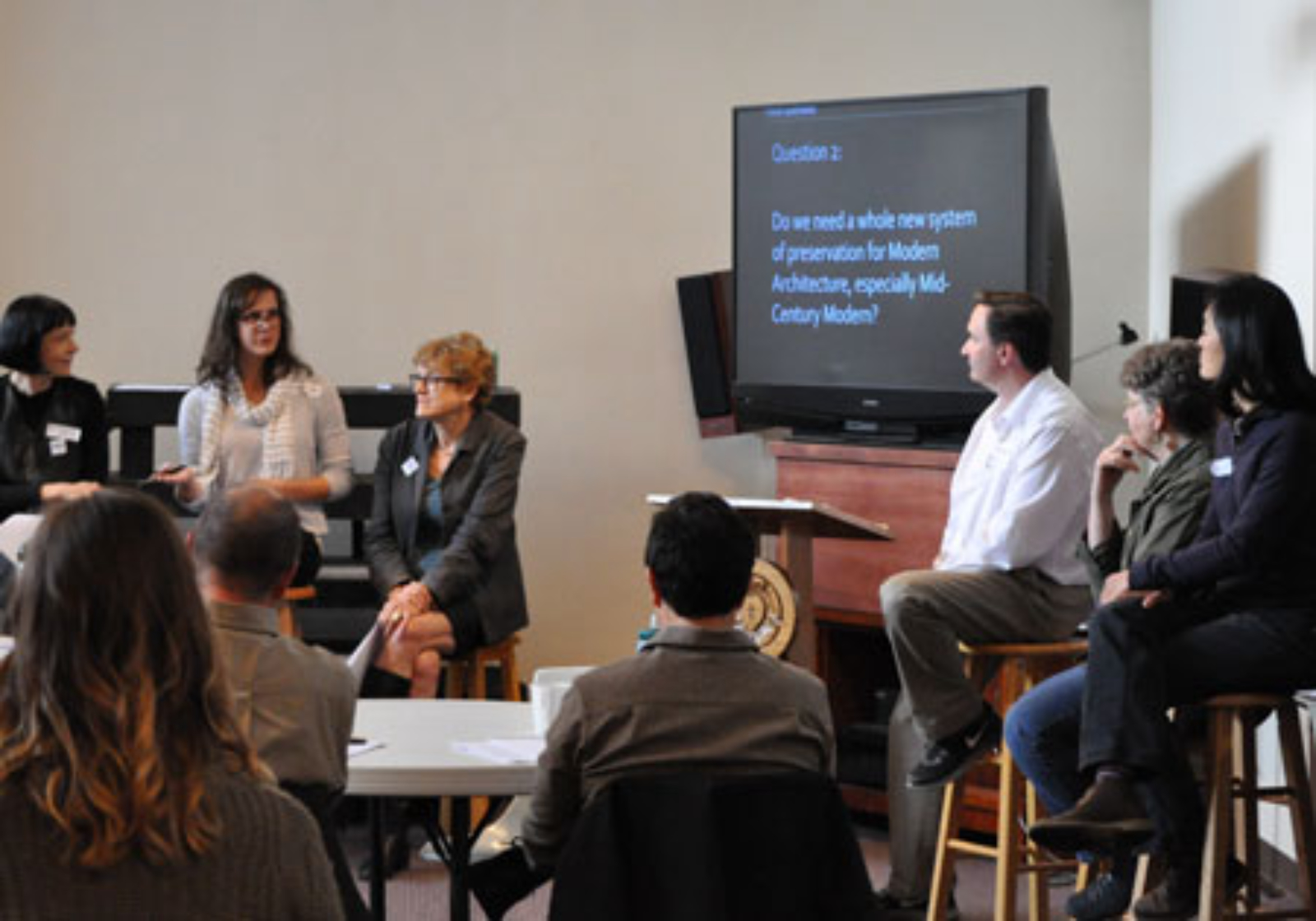 By Docomomo US/Oregon
By Docomomo US/Oregon
On May 21, 2016 Docomomo US/Oregon co-sponsored a joint workshop with the Association of Preservation Technology Northwest Chapter titled Preservation of Mid-Century Modern Building Materials. The full day event venue was held at the mid-century Pietro Belluschi designed Central Lutheran Church in Portland, Oregon.
Debate moderated by Credit: Brian Rich, AIA
After a tour and history of Central Lutheran church, the morning session began with a fascinating lecture presented by Suzana Radivojevic of the University of Oregon on Plywood in Mid-century Modern Architecture. The session provided those in attendance with an overview of the early history and technological developments of plywood and examined the applications of this novel architectural material by the architects in the Pacific Northwest prior to the 1960s. Ms. Radivocjevic then offered practical methods and technologies for preservation of historic plywood by using examples from the existing mid-century buildings.

Credit: Brian Rich, AIA
Continuing on the theme of wood, Rachele Byarly, a graduate student at the University of Oregon presented her thesis titled Glue-Laminated Timber in the Western U.S.: Its Development, Failure Patterns, and Preservation Methods. She provided an overview of the history of glulam development and manufacturing, and workshop attendees learned Glulam was first introduced to the United States in the state of Wisconsin in 1934 from Germany and gained wider acceptance after World War II. The session also touched upon the architectural applications, common deterioration patterns, and repair techniques of the building material. As these resources age, the glulam can succumb to various forms of deterioration. However, since the literature for its continued preservation is currently limited, there is need to build upon the research that does exist in order to address the conservation issues that may arise as the number of extant glulam structures over 50 years old continues to grow and become eligible for listing on the National Register of Historic Places.

Suzana Radivojevic of the University of Oregon presenting Plywood in Mid-century Modern Architecture. Credit: Brian Rich, AIA

Rachele Byarly, a graduate student at the University of Oregon presented her thesis titled Glue-Laminated Timber in the Western U.S.: Its Development, Failure Patterns, and Preservation Methods. Credit: Brian Rich, AIA
The morning session wrapped up with a presentation by Shan Wo, an engineer with Atkinson-Noland & Associates, on the Nondestructive Evaluation of Mid-Century Building Materials. Ms. Wo discussed the unknown nature of as-built conditions and the need for repair, retrofit, or renovation. Along with information on structural framing, material properties, and architectural finishes, she presented a number of case studies that used various nondestructive evaluation tools and techniques.

Presentation by Shan Wo on the Nondestructive Evaluation of Mid-Century Building Materials. Credit: Brian Rich, AIA
The afternoon session focused on examining various case studies of renovations of well-known Mid-century modern structures in Portland and Seattle. Susan Hartnett, Development Manager in the Office of Management and Finance, opened her presentation titled The Challenges of a Mid-Century Modern Spectator and Events Venue with the question, "Did you know that many of the original Mid-Century Modern materials are still in service at the Veterans Memorial Coliseum?" The VMC has many challenges in maintaining its original systems, and Susan went on to describe the way in which these systems are-or are not-performing today. The presentation also touched on the recent study examining potential options for the building's future and the choices that still need to be made concerning the functional modernization of the building.
Susan Hartnett, Development Manager in the Office of Management and Finance presenting The Challenges of a Mid-Century Modern Spectator and Events Venue. Credit: Brian Rich, AIA
Susan Boyle, AIA, a Seattle-based preservation architect and planner, and former member and chair of the Seattle Landmarks Preservation Board, presented two case studies on Seattle's Modern Era Libraries. The presentation evaluated additions to designated local landmarks designed in the post-war decades as public library services and expanded to serve growing suburban areas. The buildings -- the 1954 Northeast Branch, designed by Paul Thiry; the 1964 Magnolia Branch, designed by Paul Hayden Kirk, and the 1965 Lake City Branch, designed by Jack Morse -- represent varied efforts by masterful northwest architects to fit the library program within specific landscaped sites and surrounding neighborhood contexts.
Brian Rich, Principal at Richaven Sustainable Preservation and President of APTNW closed the workshop by moderating a panel discussion that debated the merits and value of preserving mid-century materials against the replacement of those materials. Preservationists on one side argued the intent of preserving a modern building is often less about the materials themselves than about the spaces and environments that they created. It was also pointed out that many modern materials were experimental and not intended to be preserved. The opposing side then raised the questions; how do we reconcile the need for guiding the design of interventions on Mid-Century Modern buildings with the current regulations? How can the current system be adjusted to accommodate new changes in approaches to preservation of cultural heritage? Needless to say, it was a lively discussion enjoyed by all.
Docomomo US/Oregon and APTNW both agreed the workshop was a success and look forward to hosting a similar event in 2017. Stay Tuned!

Credit: Brian Rich, AIA
